
01/02/2024 Edition
Page 2 - Displays
This page will give an overview of the types of displays found in vintage laptops, including their strengths, drawbacks, and common issues.
The earliest of laptops often used very low quality non-backlit monochrome displays. These have the same look as a typical dot-matix calculator screen, but were larger obviously. They were often stange aspect ratios, it's common to see ones that are much wider than they are tall. Some of these may have been able to display a few shades of gray? I'm not sure. They are very low-refresh rate as well. For all these reasons, this type of screen is really only suitable for business software, not games.
These displays first emerged in the mid 1980s, during the same time where the non-backlit displays were common. One example would be the Zenith ZFL-181 from 1986. Many of these early ones were white and blue rather than blue and black.
As the technology evolved, screens capable of displaying grayscale rather than just monochrome started to become common. Later ones also started to have blacks that looked more black than blue, but any of these screens still have a blue hue to them.
Passive Matrix displays suffer from poor contrast (and the need to adjust the contrast to get a good picture), poor refresh rate (so slow that moving a cursor too fast across the screen can cause it to disappear), and ghosting/artifacting issues. These are all normal characteristics of these displays and not indicitive of a problem with the panel.
These displays are generally pretty reliable, but panels from some brands do have problems with capacitor failure that will cause image ghosting to become worse than normal, and eventually will cause no picture to appear at all. More on bad caps later on. Sharp is the main brand that I've seen have these problems but I'm sure others do too.
Some high-end early laptops used orange-hue Gas Plasma displays. These displays were pretty thick, so they are only found in large luggable-style laptops. You'll never see one in a compact system. Brands that I know used these include Toshiba and GRID for laptops, and IBM and Compaq both used them in some of their bigger fully luggable computers. I'm sure other brands did too. These displays are fairly rare to come across though. While they're rare, they do have a high refresh rate and a great picture, so laptops with them are really the only ones from the 80s that can make decent gaming computers.
Unfortunately, many of these displays are quite unreliable nowadays. Early ones commonly suffer from dead columns caused by corrosion on the display driver ICs. Repair of this issue is possible, but extremely difficult. It's unclear what the corrosion comes from, but it seems to be from a factory defect of some sort rather than any external source. I think that some of the panels can have capacitor trouble as well.
Active Matrix (TFT/Thin Film Transistor) LCDs are the base technology for more modern LCD panels, and are much higher quality than Passive Matrix panels. As such, even an Active Matrix Grayscale panel can be pretty nice to run old games on, as long as you don't mind not having color.
One thing though - these screens are RARE. In fact, so rare, I can give a list of all the laptops known to use them right below:
As you can see, it's a handful of Apple laptops (which aren't covered here), and then a grand total of 3 PC laptops made by Compaq. These are the only laptops that are commonly known to exist with these displays. Only one company (Hosiden) is known to have made these. If you know of another, please let me know!
Besides being rare, these displays also have a fatal flaw known as Tunnel Vision, which is a defect now found in nearly every one of these panels today. This defect causes the corners of the screen to darken as the panel is used, causing a vignette effect that can in severe case become bad enough to engulf the whole screen in seconds. For more info on this fault, see here.
First emerging around 1992, TFT Color LCDs are the most favored LCD technology of collectors today. A TFT color screen will basically look like a lower-res, worse version of a modern LCD. A refresh rate high enough to play fast-moving games, better colors, better contrast and viewing angles, and no passive-matrix artifcating.
From what I can tell, passive matrix color panels actually came after active ones did. These displays display color, but with the same drawbacks as passive matrix grayscale panels have. Mainly, a low referesh rate, bad viewing angles, blacks having a blue hue, and some artifacting/ghosting.
These panels can range wildly in quality. For some, it can be very easy for someone knowledgeable to tell that it's a passive panel from just a still image. However, it can be incredibly difficult to tell a high-quality passive panel apart from an active one if you're looking at a still image. Once you see something moving on the screen though, it will become obvious regardless of the quality, as all passive matrix panels have obviously low refresh rates.
Passive Matrix color panels stuck around in the low-end all the way to the turn of the new millenium. Near the end, "HPA" (high performance addressing) panels came out, which supposedly had higher contrast and better refresh rates than earlier panels did. They still look more worse than a TFT/Active panel though.
If you're looking at an online listing of a laptop, and you want one with a TFT screen, how do you tell which the laptop has? The easiest way of course would be if there was a video showing movement on the screen, which would make which type it is obvious. But the vast majority of listings won't include one. So, what do you check for?
Is there any text that confirms what type of display a laptop has? A lot of laptops loved to brag about their high-end Active Matrix Color screen - so does it say so anywhere? Look out for "TFT", "STN", "DSTN", or "HPA" written anywhere. Many manufacturers that sold the same model with both types would use "S" and "T" in the model number somewhere. For example, Toshiba laptops ending in CDS were passive, while those ending in CDT were active. Other manufacturers did similar things.
It's still entirely possible sometimes to tell what type a laptop has, even with no photos of one running.
The first thing to check for is whether it has an adjustment control for brightness AND contrast. If it ONLY has one for brightness, it is very likely an Active Matrix panel. DO NOT ASSUME that if it has only one slider, that that slider is for brightness. CHECK if possible what it is labelled with. Brightness sliders, dials, or buttons are usually labelled with text, or a sun icon. Contrast sliders on the other hand are usually either labelled with text or a half-moon icon. Some laptops (like the ThinkPad 380 series) only have one slider on both the Active and Passive panels, a brightness on the Active, and a contrast on the Passive, both labelled accordingly. Be aware of this when checking a listing and keep a keen eye on those small details.
You'll sometimes see people say that if a laptop has TWO sliders/dials/sets of buttons (one for brightness and one for contrast), that means that it has a passive panel. This is correct a lot of the time, but isn't always the case. Many manufacturers just cheaped out and kept the contrast slider on Active Matrix models, even though there wasn't a point to having one. Apple did this, and they aren't the only one. Two sliders can give you a fair certainty that you're getting a Passive panel, but you can't be sure.
So, to sum everything up, if you only see ONE control, and it's labelled for brightness, you can be fairly positive that you're getting an Active panel. If you see TWO controls, one for brightness and the other for contrast, you can be fairly sure that you're getting a Passive panel, but you can't be positive.
And another note - if a laptop has the brightness and contast controls on the keyboard, you really can't assume anything. The majority would keep the contrast labels on active matrix models to save on costs.
To a skilled eye, you can also sometimes tell what type of panel you have by the look of the panel itself. Passive Matrix panels when powered off often have a blue hue to them (ESPECIALLY monochrome/grayscale ones), while most Active panels don't. Active panels usually have more of a gray or even sometimes green hue to them when off. However, some Active panels can look similar to passive panels so this isn't foolproof. The only cases where I can be sure is if I see one that's REALLY blue, or if I see one that's obviously active matrix. Here are some photo examples below:
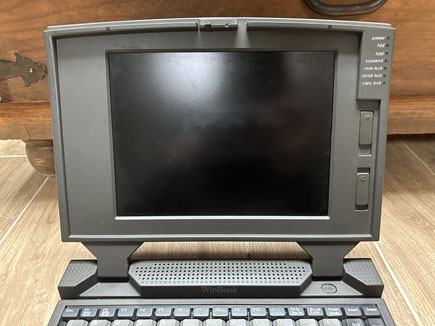
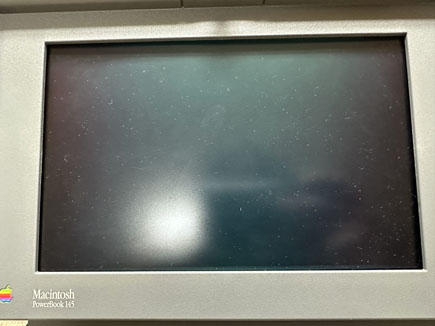
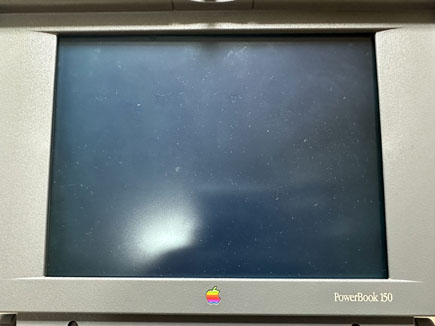
From left to right:
Sharp Passive-Matrix Color. Not very blue, more of a black color.
Sharp Passive-Matrix Grayscale. Has a blue hue as you can see.
Casio Passive-Matrix Grayscale. Quite blue.
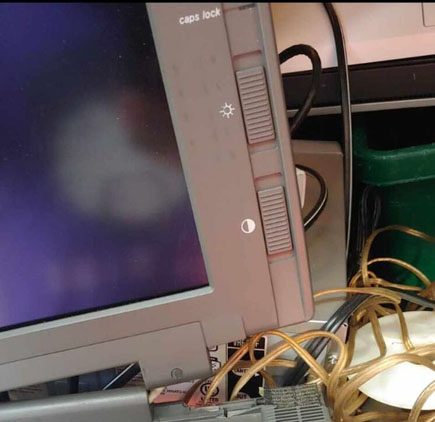
This one is a passive color display from an unknown manufacturer. Has a very prominant purple-blue hue from certain angles.
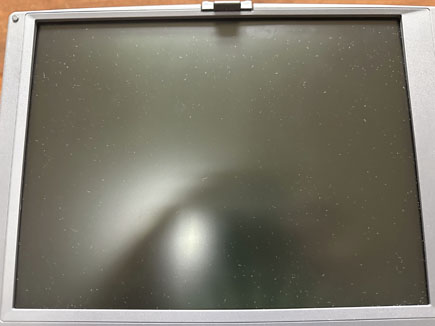
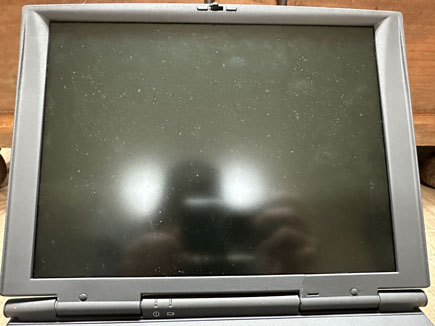
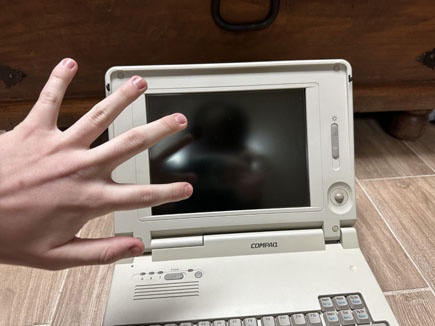
From left to right:
Active Matrix Color from an unknown manufacturer. Very standard TFT look, gray, slightly green perhaps.
Active Matrix Color from NEC. Same color shade, and more reflective than most TFT displays.
Active Matrix Color from Sharp. The early Sharp TFT panels are quite reflective as is highlighted in the photo. If you see an oddly glossy and reflective display in a laptop from around the 1992-1994 time period, it's likely got one of these panels.